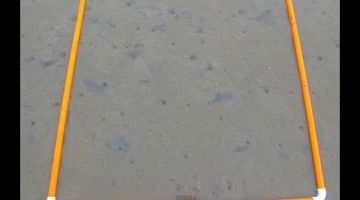Andrew Swales and Raiha Tuahine from NIWA use quadrats to view and record samples of marine life in an estuary.
Field guides
Look online or in your local library for field guides that will work for your location and survey. Why not try the NZ Marine Field Guide app from Auckland Museum or the Otago University Flora Finder.
Transcript
VOICE OVER
Scientist Andrew Swales and lab technician Raiha Tuahine are using quadrats to sample marine life in an estuary
Firstly, they use a measuring tape and line it up between objects so that they can identify where the quadrat samples are taken from. This is so they can come back to the same place at a later time for subsequent samples. The measuring tape also helps them to space out their samples.
They place the quadrat at an agreed spot next to the tape and note the measurement on the tape. They record the date and time and use their plant identification field guide to identify the plant in the quadrat. It is a clump-forming sedge called Three-square.
They take another sample a few more metres down the measuring tape. It is seagrass.
Andrew and Raiha take a smaller quadrat even further down the line into the estuary. Andrew digs through the sand and mud and finds some shellfish.
Raiha identifies what they are and records them.
Acknowledgements:
Andrew Swales and Raiha Tuahine - NIWA
Waipapa Marae, Kāwhia


